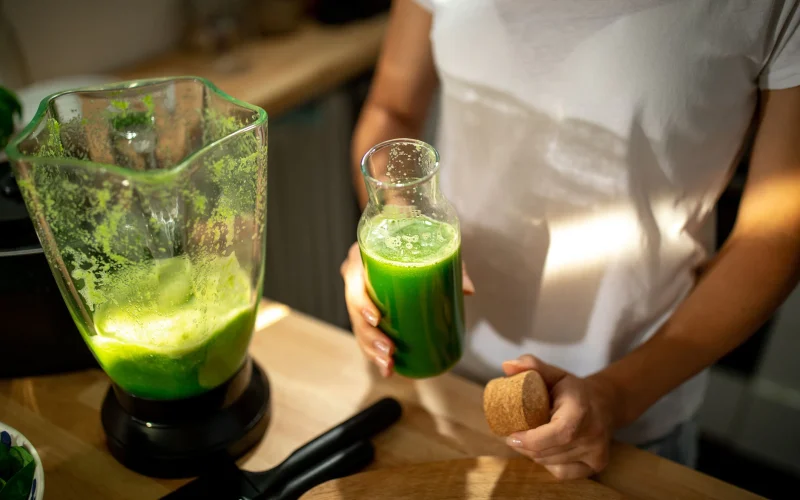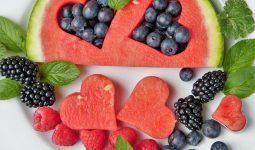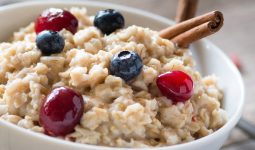Juice and smoothies are similar in that they are both excellent sources of fresh micronutrients and natural enzymes.
You’re unlikely to eat an apple, half a lemon, two raw carrots, a handful of raw spinach, some raw beetroot, and a stick of raw celery on a platter. However, when blended in a juice or smoothie, they look fantastic!
Smoothies are usually thick drinks produced from a combination of whole foods, whereas juicing typically extracts the liquids from fruits and vegetables, which contain most of the nutrients.
If you’re looking for a nutritious drink, you might wonder whether smoothies or juices are healthier.
Smoothies and juice can be healthy, but speaking from a nutritionist’s or registered dietitian’s perspective, I can assure you that there is no one-size-fits-all answer.
It all boils down to your own needs and ambitions. Here’s the lowdown on each beverage to help you decide which one is best for you (regardless of what your friends, workplace, or favorite celebrities are drinking).
Juice and smoothies are popular beverages made from fruits and vegetables, but their ingredients, preparation methods, and nutritional content differ.
Let’s dive into the critical “difference between juice and smoothies”:
1. Ingredients
One significant difference is in the ingredients. Juices are typically made by extracting the liquid from fruits or vegetables, leaving the pulp and fiber behind.
The result is a liquid containing the fruits or vegetables’ vitamins, minerals, and sugars. Smoothies, on the other hand, aren’t produced this way.
Instead, they use whole fruits or vegetables, including fiber-rich pulp. They are blended, not juiced, resulting in a thicker beverage that retains the nutritional benefits of the entire ingredient.
2. Texture
Another notable difference between juice and smoothies is the texture. Juice is a liquid; its texture is smooth and precise since it doesn’t contain the fiber and pulp of fruits or vegetables.
However, smoothies have a thicker, more viscous texture due to the inclusion of whole fruits or vegetables. The fiber content contributes to a smoother and creamier consistency.
3. Fiber Content
Smoothies often tend to contain more fiber than juice. The fiber content of juice is significantly reduced since the pulp is removed during juicing.
While juice includes vitamins, minerals, and natural sugars, it lacks the dietary fiber in whole fruits and vegetables. Unlike smoothies, juice has less fiber, making a significant difference.
However, the fiber content in smoothies is retained because the entire fruit or vegetable is blended. This fiber can contribute to better digestion, satiety, and a slower release of sugars into the bloodstream.
4. Nutritional Content
While juice provides essential vitamins and minerals, it may have a higher concentration of sugars without the moderating effect of fiber.
It can be nutrient-dense but may need more satiety and a complete nutritional profile of whole fruits and vegetables.
Smoothies retain the complete nutritional profile of the ingredients, including fiber.
They offer a more balanced combination of vitamins, minerals, antioxidants, and fiber.
5. Caloric Density
Due to the concentrated sugars and reduced fiber content, juice can be higher in calories and have a higher glycemic index.
In smoothies, the fibers help regulate the absorption of sugars, potentially resulting in a lower glycemic index and a more sustained release of energy.
Added ingredients like yogurt, milk, or sweeteners can also influence the caloric density.
6. The Satiety Level
Because juices lack fiber, they may not provide the same satiety level as whole fruits, vegetables, or smoothies.
However, the fiber content in smoothies can contribute to a feeling of fullness and satisfaction, making them a more filling option.
7. Processing
Juice usually involves using a juicer or a pressing method to separate the liquid from the solid components.
At the same time, smoothies are made by blending fruits and vegetables using a blender, which retains all the features of the ingredients.
8. Added Ingredients
Some commercial fruit juice may have added sugars, preservatives, or other flavorings.
Smoothies, however, include a variety of additional ingredients such as yogurt, milk, nut butter, protein powder, or greens.
These added components can enhance the nutritional profile and taste but may also contribute to higher calorie content.
9. Digestive Impact
Some people find that quickly consuming large quantities of juice can rapidly influx sugars into the bloodstream, potentially impacting blood sugar levels.
The fiber in smoothies, however, slows down the digestion and absorption of sugars, providing a more gradual release of energy and potentially avoiding rapid spikes in blood sugar.
10. Convenience
Juice is a more convenient drink than smoothies. They are commercially available juices that are convenient and portable.
They are often sold in bottles or cartons and can be consumed on the go.
While smoothies can be made at home with a blender, bottled juices might be more convenient to transport. However, some establishments offer pre-made smoothies.
Convenience, as a difference between juice and smoothie, should be one of the primary reasons you choose any of these two beverages.
11. Nutrient Retention
The juicing process may lead to some loss of heat-sensitive nutrients like vitamin C and certain antioxidants.
However, smoothies retain more nutrients since the entire fruit or vegetable is used, and no heat is involved.
12. Dental Health
Smoothies have a more positive impact on the teeth than juices. Some fruit juices can be acidic and contribute to dental erosion, especially if consumed frequently or concentrated.
Smoothies, however, can help mitigate the impact on dental health by reducing the contact time of sugars with teeth.
13. Culinary Versatility
Fruit juice is primarily consumed as a beverage but can also be used as an ingredient in cocktails, marinades, or sauces.
However, smoothies are more versatile than juice and are often consumed as a meal replacement, snack, or dessert.
14. Digestive Health
Unlike smoothies, the fiber content in whole fruits and vegetables is absent in juice.
Fibers are essential for digestive health and can help prevent constipation.
Smoothies retain the fiber from the entire fruit or vegetable, promoting digestive regularity and contributing to a healthy gut.
15. Customization
Juices are limited in customization as they primarily extract the liquid from fruits or vegetables. Smoothies, on the other hand, are highly customizable.
You can add various ingredients, such as fruits, vegetables, protein sources, and liquids, to suit your taste and nutritional preferences.
16. Meal Replacement
Juices are less commonly used as a meal replacement. They are often only consumed as a beverage.
Juices do not provide the type of satiety smoothies give to its consumers.
However, smoothies are frequently consumed as a meal replacement, especially when additional ingredients like protein powder, yogurt, or nut butter are added, providing a more substantial and satisfying option.
17. Weight Loss
Juice and smoothies also differ in how they contribute to weight loss.
Some juice cleanses or detox diets promote weight loss, often due to calorie restriction and water loss rather than sustainable fat loss.
The fiber and potential inclusion of protein in smoothies can also contribute to a feeling of fullness, potentially supporting weight loss by reducing overall calorie intake.
18. Cost of Preparation
Commercially available juices can be relatively expensive, especially if freshly pressed or made from organic ingredients.
On the other hand, smoothies are often made at home; thus, they can be more cost-effective, mainly if you use frozen fruits and vegetables.
19. Allergen Concerns
Juices are generally free from common allergens, but some commercially available juices may have added ingredients that could pose allergen risks.
However, ingredients like nuts, dairy, or soy can be expected in smoothies, potentially posing allergen concerns for individuals with allergies.
20. Sustainability
Smoothies tend to be more sustainable than juices. Juice production may involve significant water usage and energy consumption, especially in large-scale commercial operations.
Meanwhile, the environmental impact of smoothies depends on the ingredients used and the production methods.
Using locally sourced, seasonal produce can contribute to sustainability, making a difference between Juice and smoothies.
21. Hygiene and Cleanliness
The juicing process involves separating the liquid from the solid components, and if not done with proper hygiene, there is a risk of bacterial contamination.
The blending process, however, involves incorporating whole fruit or vegetables, which may reduce the risk of bacterial contamination compared to juicing.
22. Shelf Life
It is no news that a juice packet has a longer shelf life than a smoothie.
Freshly squeezed juices have a longer lifespan than smoothies, mainly because they contain preservatives, and they are sometimes not made with natural fruits but with fruit alternatives.
Unlike juices, smoothies are best consumed immediately for optimal taste and nutrient retention. Smoothies have a limited shelf life because they are often made without preservatives.
23. Culinary Creativity
Although juice allows for creativity by combining different fruits and vegetables, the options are more limited than those in smoothies.
Smoothies are highly versatile and allow various ingredient combinations, including fruits, vegetables, liquids, and additional supplements.
24. Accessibility of equipment
The juicing process requires specific equipment (such as a juicer), which is not readily available in most households.
As for smoothies, a standard blender is all you need, and it is generally more accessible and available in most households. Ingredients like frozen fruits and vegetables add to the convenience.
25. Cultural and Regional Preferences
Popular juice choices may vary based on cultural and regional preferences.
For example, orange juice is a common choice in many Western countries, while coconut water is prevalent in tropical regions.
Cultural and regional culinary traditions can only influence the choice of additional smoothie ingredients and flavors.
26. Impact on Blood Pressure
Juices, especially those high in sodium, can significantly increase blood pressure.
However, unlike juices, smoothie ingredients like potassium-rich fruits and vegetables positively affect blood pressure regulation.
The impact of a drink on blood pressure is something that should be taken seriously, especially for hypertensive individuals.
27. Post-workout Nutrition
Smoothies are a go-to post-workout liquid, more so than juices. This is because juices lack sufficient protein content for optimal post-workout recovery.
Conversely, smoothies can be protein-rich, especially yogurt, protein powder, or nut butter. They can be a more balanced option for post-exercise nutrition.
28. Personalization for Dietary Needs
Some individuals with specific dietary needs, such as those on low-carb diets, may find it challenging to incorporate juices due to their natural sugar content.
At the same time, smoothies can easily be personalized to accommodate various dietary preferences and restrictions, including low-carb or high-protein options.
In Summary,
The difference between juice and smoothies cannot be overemphasized; it includes taste preferences, lifestyle when making these beverage choices, health differences, and so on.
They also have some similarities, such as the fact that they can be made from fruits, their hydration benefits, etc.
When deciding between juice and smoothies, factors related to hygiene, temperature sensitivity, shelf life, nutrient retention, and so on should be considered.
Individual preferences and health goals should guide decisions as with any dietary choice.








